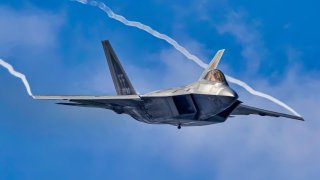F-22 Raptor vs. F-35 Lightning II Is the Ultimate Stealth Fight (And It Just Happened)
Recently, two U.S. Air Force F-22 Raptors engaged in dogfights with two South Korean F-35As over the Korean Peninsula, showcasing their capabilities.
Summary: Recently, two U.S. Air Force F-22 Raptors engaged in dogfights with two South Korean F-35As over the Korean Peninsula, showcasing their capabilities.
The F-22, the first operational stealth fighter, will eventually be replaced by the Next Generation Air Dominance (NGAD) fighter jet.
Battle of the Stealth Fighters: U.S. F-22 Raptors and South Korean F-35s Engage
The F-22 Raptor and F-35 Lightning II stealth aircraft are the most advanced fighter jets in the world. The F-22 Raptor flies solely for the U.S. Air Force, while the different versions of the F-35 Lightning II can be found in 18 countries.
The two aircraft have different missions. The F-22 is an air superiority fighter jet designed to clear the airspace of enemy aircraft and open the way for other friendly assets. The F-35 is a multirole fighter jet that can connect and direct allied air, ground, and naval units, while also taking out targets in the air and on the ground.
Both aircraft are extremely capable in their roles, and it is very rare to see them go up against each other.
F-22 Raptor v. F-35 Lightning II
Last week, two U.S. Air Force F-22 Raptors went up against two South Korean F-35A Lightning IIs over the southern part of the Korean Peninsula.
According to the Korean Air Force, the stealth aircraft fought against one another in dogfights, taking turns in offensive and defensive maneuvers. On paper, the F-22 is better suited for such close-quarters engagements, and it should have the advantage over its more modern cousin.
The Raptors are assigned to the U.S. Air Force’s 19th and 199th Expeditionary Fighter Squadrons out of Joint Base Pearl Harbor-Hickam, Hawaii, but have been operating out of Kadena Air Base, Japan, for the past few weeks. During their stay in Korea, the F-22s are housed at Kunsan Air Force Base.
The ability to deploy aircraft across the operational theater quickly and efficiently falls under the concept of Agile Combat Employment (ACE).
“ACE, force packaging aircraft and personnel in order to rapidly and successfully conduct operations in various strategic locations, remains a top training priority as it is crucial to meeting theater requirements,” the Air Force’s 8th Fighter Wing in Kunsan Air Force Base stated in a press release.
The F-22 Raptor is the first operational stealth fighter jet. Introduced in the early 2000s, the F-22 Raptor saw its production line cut short to reallocate resources to the F-35. As such, Lockheed Martin produced only 186 F-22 Raptors, and of that number, less than 100 remain operational today. (The exact number remains classified.) The Air Force intends to replace the aircraft with the Next Generation Air Dominance (NGAD) sixth-generation fighter jet, and Congress has taken measures to ensure that the F-22 remains in service until the NGAD is ready.
The F-35 is the most advanced fighter jet in the world. However, unlike the F-22, it doesn’t mainly focus on air superiority, but can accomplish several other mission sets, such as Strategic Attack; Intelligence, Surveillance, and Reconnaissance; Close Air Support; Electronic Warfare; Suppression of Enemy Air Defenses; and Destruction of Enemy Air Defense.
About the Author
Stavros Atlamazoglou is a seasoned defense journalist specializing in special operations and a Hellenic Army veteran (national service with the 575th Marine Battalion and Army HQ). He holds a BA from the Johns Hopkins University and an MA from the Johns Hopkins’ School of Advanced International Studies (SAIS). His work has been featured in Business Insider, Sandboxx, and SOFREP.


